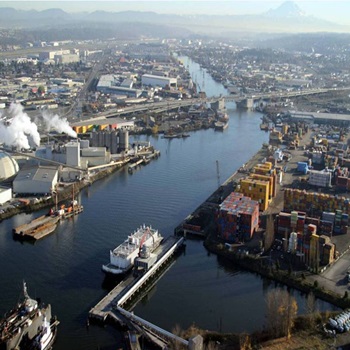Lower Duwamish Waterway Superfund Cleanup
Project update
Spring 2025
The first season of cleanup of the Lower Duwamish Waterway’s upper reach is complete!
Visit ldwg.org to learn about the progress made this season. Construction season 2 will resume in October 2025.

Barge dredging sediment from the Duwamish river during the Superfund cleanup.

The Duwamish waterway flows through an industrial area of Seattle but most of the pollution found in river sediments were introduced to the river the past.
The Lower Duwamish Waterway (LDW) represents the last five miles of the Duwamish River. Historic activities such as wartime manufacturing, shipping activities and the disposal of raw sewage left the waterway polluted by contaminants including PCBs and phthalates. Now, stringent environmental laws no longer permit industries to discharge process water directly into the river. The biggest source of pollution in our waterways today comes from stormwater runoff from streets, parking lots, homes and commercial/industrial businesses.
In 2001, the U.S. Environmental Protection Agency (EPA) used the federal Superfund law (also known as Comprehensive Environmental Response, Compensation, and Liability Act, CERCLA ) to begin its own cleanup efforts and liability assignments in the Lower Duwamish. The Washington State Department of Ecology is also involved, using its authority under the Model Toxics Control Act.
Partnerships in the LDW Cleanup
The Lower Duwamish Water Superfund cleanup builds upon decades of work by King County and its partners to improve water and sediment quality in the Lower Duwamish. The waterway is cleaner today than it has been in nearly a century.
LDW Superfund Cleanup current activity and progress
The Lower Duwamish Waterway Group (LDWG), a partnership between King County, the Port of Seattle, City of Seattle and The Boeing Company, has been actively cleaning up waterway pollution.
About Superfund
The Lower Duwamish Waterway is a working river that has supported Seattle’s economy for more than 100 years. Most of the pollution comes from past industrial practices and development decisions that would no longer be permitted today. These practices allowed contaminants to enter the waterway and settle into the sediment in the bottom of the river. The U.S. Environmental Protection Agency, or EPA, listed the river as a federal Superfund cleanup site in 2001 to address this historical pollution in the river sediment.
Staying safe while using the river
Studies have found a variety of chemicals including heavy metals, oil, industrial waste and sewage in the lower Duwamish river. The biggest chemicals of concern are polychlorinated biphenyls, or PCBs, which have been banned since the 1970s. PCBs are linked to cancer. Other toxins include arsenic and dioxins. PCBs, dioxins and arsenic are toxic to people and wildlife.
Library and resources
This page contains reports, studies, plans, glossary and other documentation for the Lower Duwamish Waterway Superfund Cleanup.

 Translate
Translate